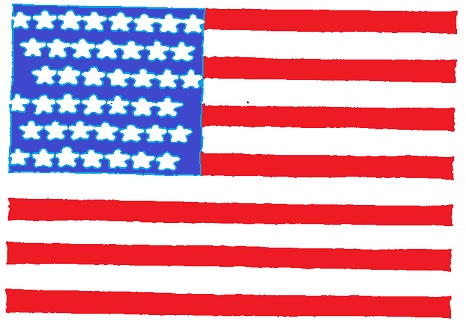* * * * * U.S.A. Flag 1890-1891
The correct official flags that flew over the Independence Day celebrations in 1890 showed the addition of five new stars to the canton, the thirty-ninth through the forty-third. These honored five new states -- North Dakota, South Dakota, Montana, Washington, and Idaho.
Unfortunately, few of the Stars and Stripes that flew that July 4 -- and on many of the succeeding days showed the correct number of stars. When the four omnibus states entered the Union in November 1889, many flag makers prepared banners with forty-two stars in anticipation of the forthcoming July 4 change. But with the last-minute admission of Idaho on July 3 all such flags became unauthorized. Normally, a number of correct flags would have been manufactured, but just six days later (July 10) President Harrison signed a bill admitting Wyoming to the Union. Now, with the sure knowledge that all forty-three-starred flags would be obsolete in a year, few people bothered about displaying the correct Stars and Stripes. As a result a bewildering variety of national flags represented the United States for almost a year: some with forty-two stars; a few with the correct number of forty-three; others jumping the gun with forty-four stars; and, as usual, a host of unauthorized and obsolete banners with lesser numbers of stars.

* * * * * U.S.A. FLAG 1891-1896
The flag of forty-four stars came into being July 4, 1891, when Wyoming's star was added to the canton. At that time Benjamin Harrison was serving as the twenty-third President of the United States.

When Harrison sought re-election the -following year he was defeated by Grover Cleveland, who had been the twenty-second President. The question then arose: Was Cleveland in his second term still the twenty-second President or was he now the twenty-fourth? Not a momentous problem, it is true, but one that persisted until 1950 when the Congressional Directory, the last major holdout, decided that Cleveland was really two Presidents, the twenty-second and twenty-fourth. Thus, in 1897 William McKinley became the twenty-fifth, and so on.
